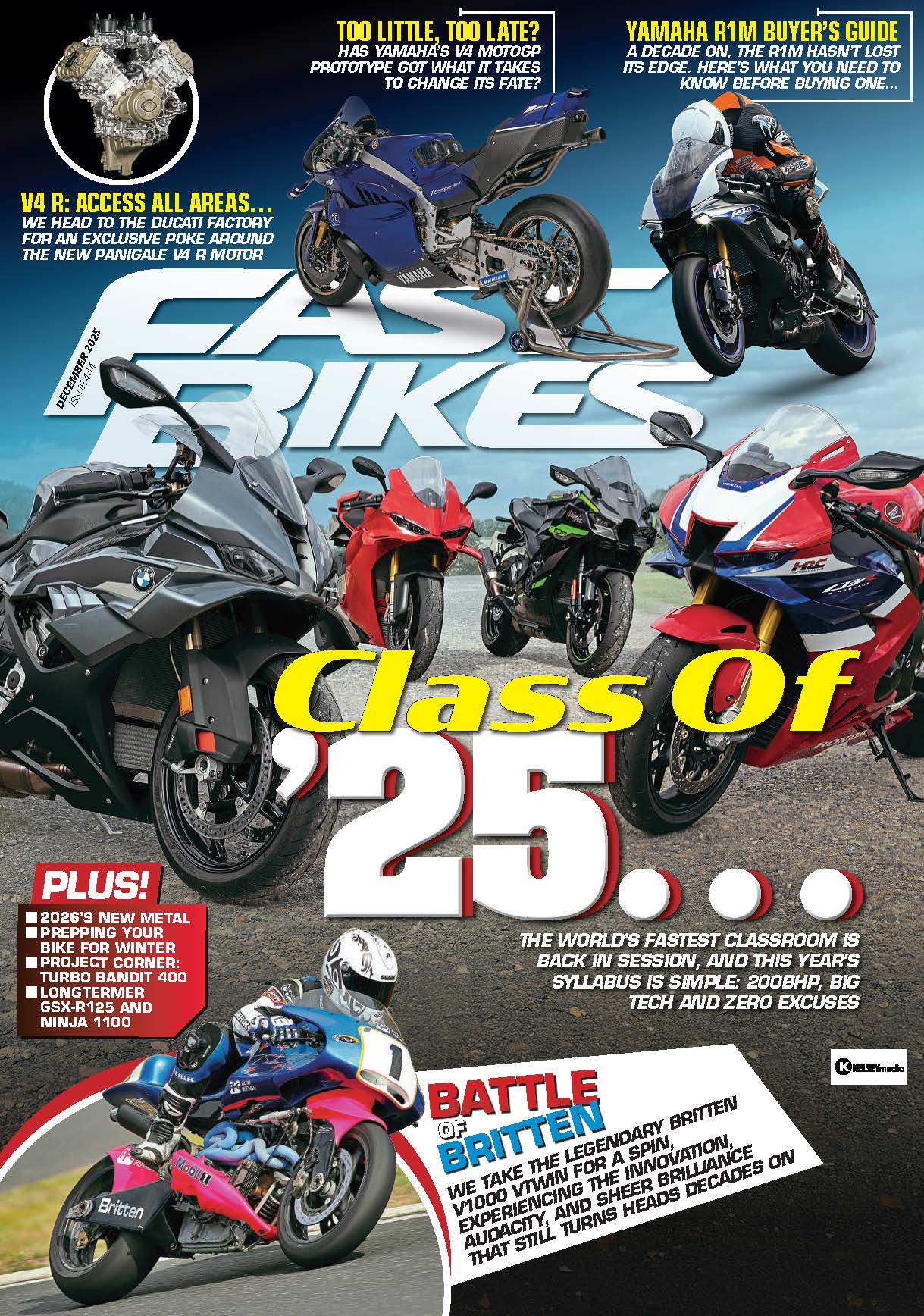Brimmed with mechanical upgrades, fresh electronics and a sharper, more refined ride, the 2025 Ténéré isn’t just more capable… it’s more committed than ever to ruling the off-road world. Bruce Wilson got to grips with it…
Covered in dirt, breathing like an asthmatic shoplifter and slowly roasting under a scorching sun, I needed no convincing that I was in my element. As sadistic as it might sound, miles from anyone or anything, staring at the endless mass of desert before me, my sense of adventure was bouncing off the limiter, and that was all thanks to Yamaha’s newly launched Ténéré 700.
In true keeping with the original spirit of this best-selling middleweight masterpiece, Yamaha didn’t beat around the bush when it came to ascertaining the kind of terrain and trails to launch their latest iteration adventure bike; it had to be hard, it had to be hairy, it had to be here… in the Agafay Desert.
There aren’t many invites that come to us with a request for blood types, or the caveat of needing to be an experienced off-road rider to attend, but this was one of those times and I’d been looking forward to the trip for many weeks in the build-up. Of course, the thing I was most looking forward to was experiencing just how far Yamaha had pushed the envelope with the new Ténéré.
Building on the firm foundations of the versions that’d come before, with over 70,000 units sold in Europe alone since the model arrived on the scene in 2019, there were no two ways about it; this next generation had to hit the mark. And to ensure it did so, a surprising amount of the bike’s been changed. Admittedly, from 20 metres away you’d be forgiven for thinking that’s not the case, but from that distance you probably wouldn’t be able to notice that the seat’s lower at the front, the tank’s been moved farther forward, or that the KYB forks are wholly different, and now fully adjustable.
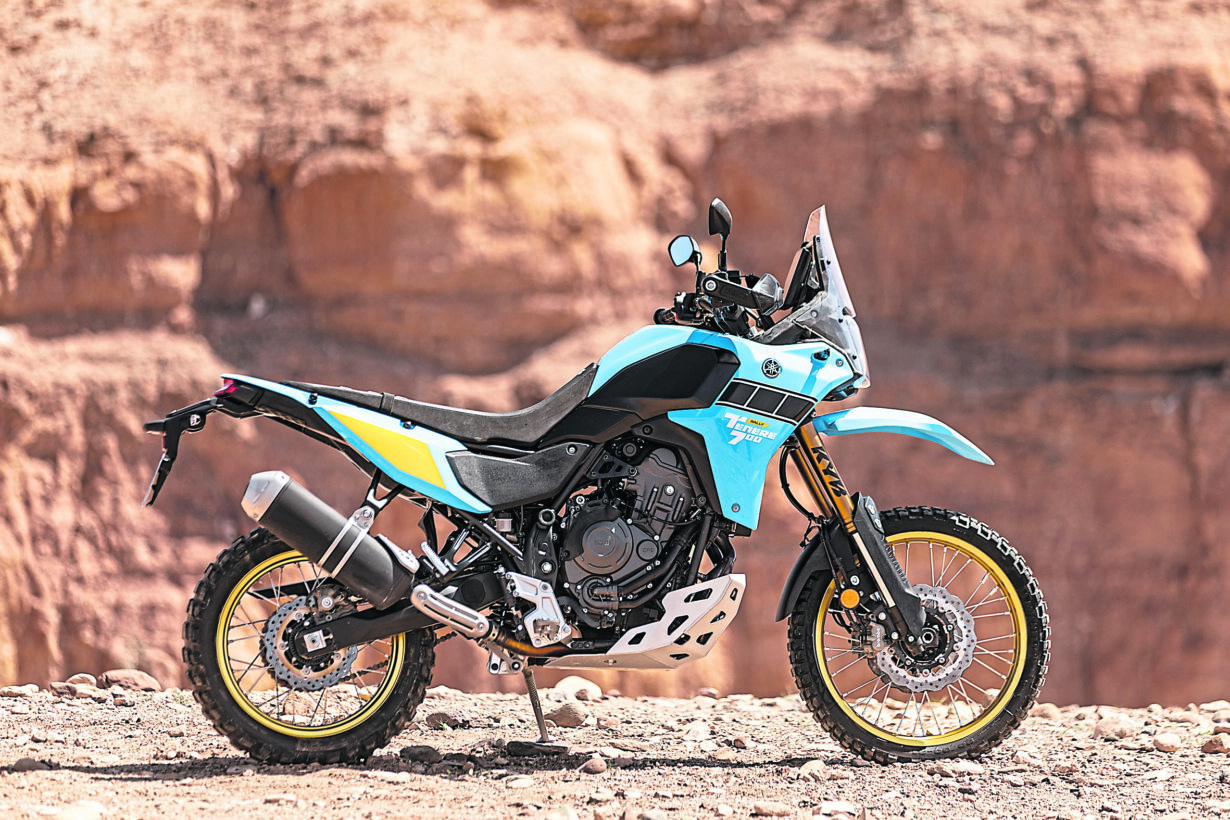
At the rear, the shock linkage is a different shape and the unit’s got an extra 7mm of stroke, despite keeping the same amount of wheel travel. And then there are the new pegs. While those that are using this bike for commuting and suchlike might not get what the fuss is all about, the 36 per cent increase in surface area means a lot when you’re riding this bike in its natural, all-terrain habitat. More peg equals more grip, and with more grip you get more control. Keeping on with the smaller, but significant, details, Yamaha’s even gone to the effort of rotating the clutch cover forward by 35˚so the rider’s boots have more space to play.
Get a bit closer and the changes keep coming hard and fast. Perhaps the most obvious of all is to the full colour, 6.3” TFT dash. Still in a portrait stance, it’s fully loaded with the kind of features and connectivity you would expect from a contemporary display, including turn-by-turn navigation, music control and even email previews… so there’s no escaping the office.
The dash is the hub for new tech, in the form of power modes, traction control and switchable ABS. More on that later, but what you need to know is that this new raft of electronic wizardry is largely owed to the switch to a ride-by-wire throttle, as per the latest MT-07. That’s one of the major changes to the Ténéré, which sees the same CP2 motor in place, albeit with revisions to the gearbox – for slicker shifting – and an earlier arrival of peak torque, thanks to the optimisation of the Yamaha’s fuelling and a new airbox intake duct. Last, but not least, every piece of bodywork on the bike is new for 2025, being sleeker and more purposeful, while the quad lights up front are also uprated for the new bikes.
In a stuffy tent, gagging to get the ride underway, this amount of info delivered seemed to take a lifetime to hit our ears, but it was nonetheless the clearest reflection of how much time and effort Yamaha had put into the new model… or, I should say models. For 2025 there’s a trio of new bikes on the cards, including the Standard, Low Seat and Rally-spec options.
For me, the day was set to kick off on the Rally, which differed to the Standard thanks to taller and fancier KYB suspension (up by 20mm at both ends), while a Rally-specific seat, that’s also 20mm thicker and sports three grip ribs, meant the saddle height was up at a whopping 910mm.
Throw in titanium pegs, a 4mm aluminum skid plate, plus a ‘Raid’-themed dash (two individual trip metres), and that would leave just the sky blue paint job to talk about. It really did look the part, and having clambered on to its seat with relative ease – despite being just 5’ 9” – I soon found myself at home on the beauty. It felt every bit a tall-seated, wide-barred adventure bike, albeit without an overbearing of weight to catch you out when sat static on the thing. Don’t get me wrong, at 210kg the Rally is no featherweight, but its mass seemed well packaged, and the minute we had our wheels in motion, the lardy-ness of the bike seemed to vanish quicker than my monthly salary… which is saying something.
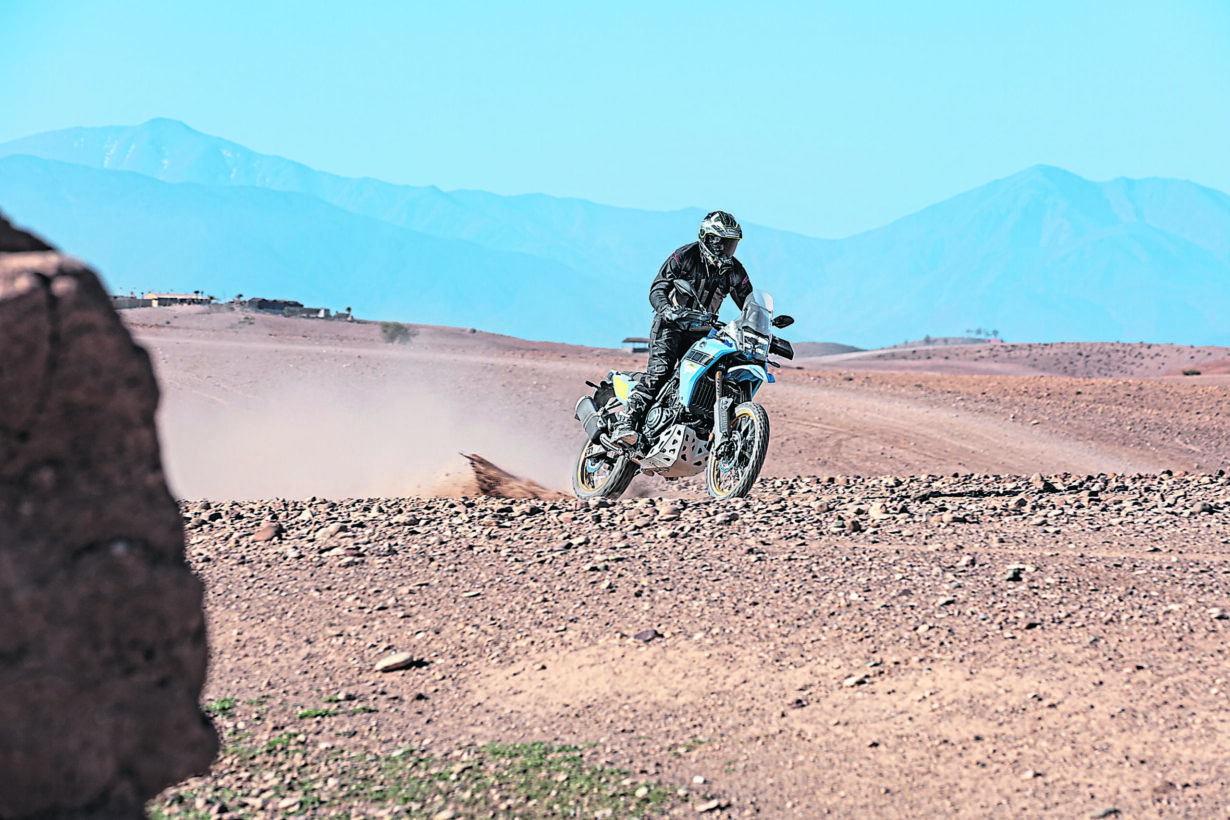
For us, having already woken up at a camp in the desert, there was no gentle warm-up to get acquainted with the Ténéré, instead being egged on into the wild, passing camels, rocks and wadis aplenty. The adventure was underway and it felt remarkable how quickly I was at home on the Ténéré, stood tall on the pegs and breathing in the endless swirls of dust from our lead rider. At times, it was a nightmare to see anything, which meant the poor Yamaha was having to smash its way through an endless flow of rocks and other unsighted lumps and bumps, but it did it with utterly brilliant table manners.
I’ve ridden every Ténéré since the model first came about and never before had one felt as plush and forgiving as the Rally did, literally taking whatever abuse came its way without any tantrums. It just floated over the ever-changing terrain, while stomaching last-minute changes of direction a treat. To get the bike turning at its best, weighting the pegs was undoubtedly the preferred approach, while a bit of rear brake action soon got the tail end steering the bike that bit sharper.
Across all models, there are three levels of ABS on tap: ABS front and rear; ABS front only; ABS off completely. I’d started the ride with the former, before switching to the middle option, but before long I realised I felt most in control with the ABS off completely. Not only because it meant I could slide the bike into turns, but also because it meant I wasn’t vulnerable to being caught out by the tech engaging when I needed it least.
Described as a desert, the tracks we were hitting were so varied, ranging from completely off-piste and desolate, to tight and nadgery climbs up the side of big rock faces; lock the front on the latter and you’d be wishing you’d packed a parachute over a camelback. I only had a few such moments, but it was enough to make me think twice about the tech, and I was also a little skeptical of the traction control.
There were some pretty steep climbs on our travels, bounding up very loose surfaces, and despite the best efforts of the CP2 motor, with the TC on, the bike felt more chastised than a 16th century servant. It really did not like the tech, and nor did I. It had to go, which meant stopping the bike and toggling through the TFT dash with the Yamaha’s new 5-way joystick on the left switchgear. By contrast, it’s worth mentioning that switching the ABS to your preferred setting is much easier to do, and can be done on the go by holding the ABS button in the cockpit area for three seconds.
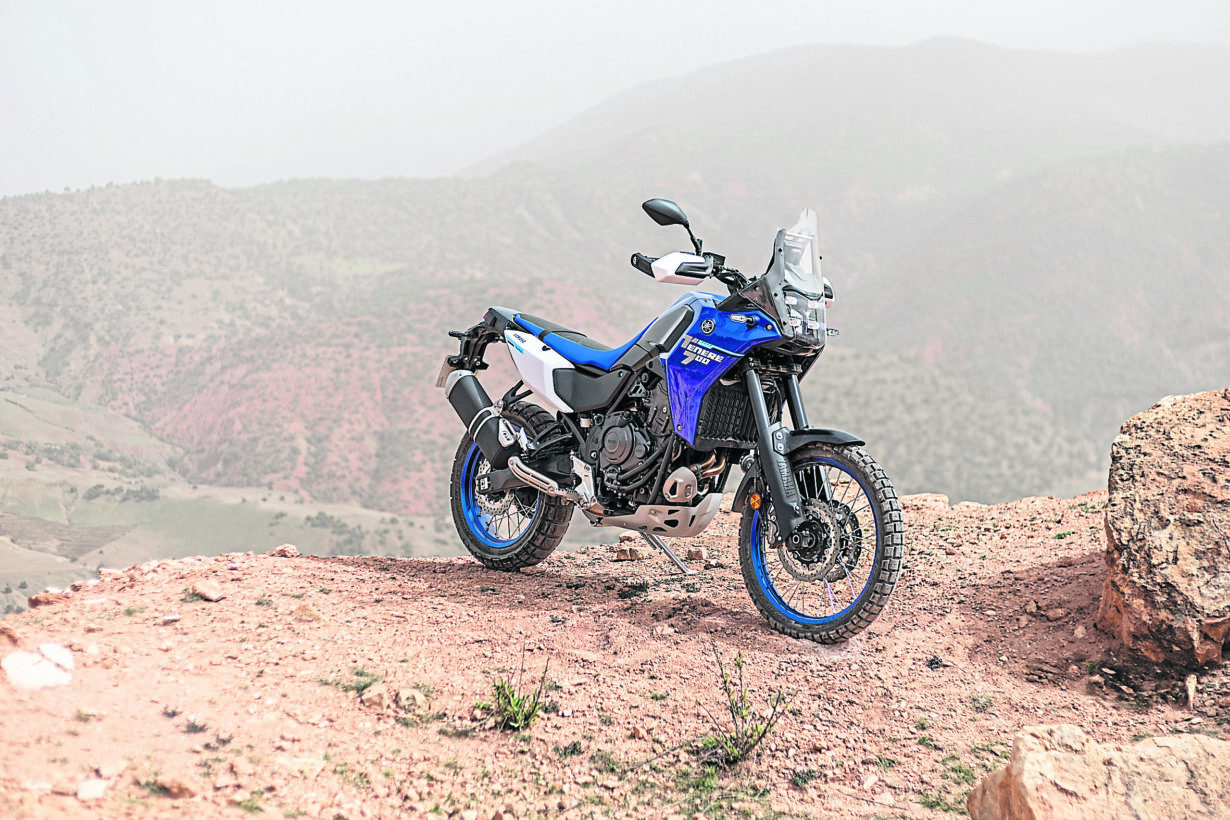
Last, but not least on the tech front, now’s probably a good time to mention the power modes. The Ténéré has two to toggle between (1-Sport / 2-Explore). I actually preferred the delivery of the level one, which was a lot sharper and more playful, but far from intimidating. If we’d been riding on typical, wet and muddy UK green lanes, I dare say the softer hitting level 2 would have come into its own, but our ride was all about going fast, breaking traction and seeing how many rocks we could fire at the rider in tow.
Perhaps one of the most memorable parts of the ride was across a recently dried flood plain, with super-grippy mud that was exceptional for drifting the rear on over massive arcs, imitating the look of muck spreaders in the process. At this point I got a good and proper appreciation of both the CP2’s clinical spread of power, but also how effortlessly it could brake traction on demand, thanks to its thumping 68Nm of torque.
While there are some that’ll say Yamaha should have cranked up the output of the Ténéré (the 72bhp and 68Nm of torque remain the same as before), I beg to differ. I’ve ridden much more powerful adventure bikes off-road and they’re not often anywhere near as much fun, or manageable.
With power often comes mass, which never helps, and then you’ve got the lack of finesse that arises when trying to put excessive amounts of power down into an often broken or inconsistent surface. It can soon catch you out and leave you questioning whether you’d be better off putting the thing in limp mode, or such like. Whereas, on the Ténéré, I honestly found myself content with the exact amount of power it had on tap; not too much, not too little. Best of all was how direct the connection felt between the throttle and the rear wheel’s drive. There were no lulls, very little snatch and once the wheels were spinning, it was easy to moderate the throttle in either way without causing the bike to get too upset.
That said, it’s worth mentioning that the back torque on this thing is pretty substantial and can catch you out if ever you’re rolling on and off in first gear. I rarely dropped below second, for this reason, preferring to slip a bit of clutch if, and when, necessary, as it made the ride a whole lot smoother. One particular area where lots of slip was needed was during a rocky climb that would’ve been best suited to a lightweight and nimble enduro machine, but the Ténéré took it all in its stride, bouncing from one rock face to another.
It was yet another chance to appreciate the sheer brilliance and versatility of this bike, while taking note of how hard the aluminum sump guard was working. There weren’t many moments when it wasn’t being smashed into the ground, or deflecting rocks that’d been pinged up by the front wheel. It certainly earned its crust, and the same can be said of the handguards that took quite a few blows along the way.
In total, we got three solid hours in the saddle of the Rally, tackling everything from wadis to mountain passes, deep sand sections to hardpacked berms. It really, really impressed me, to the extent that I was a little bit gutted to be parting company with it. Of course, by doing so, it meant I’d get a chance to try out the Standard version, but could it live up to the Rally’s brilliance?
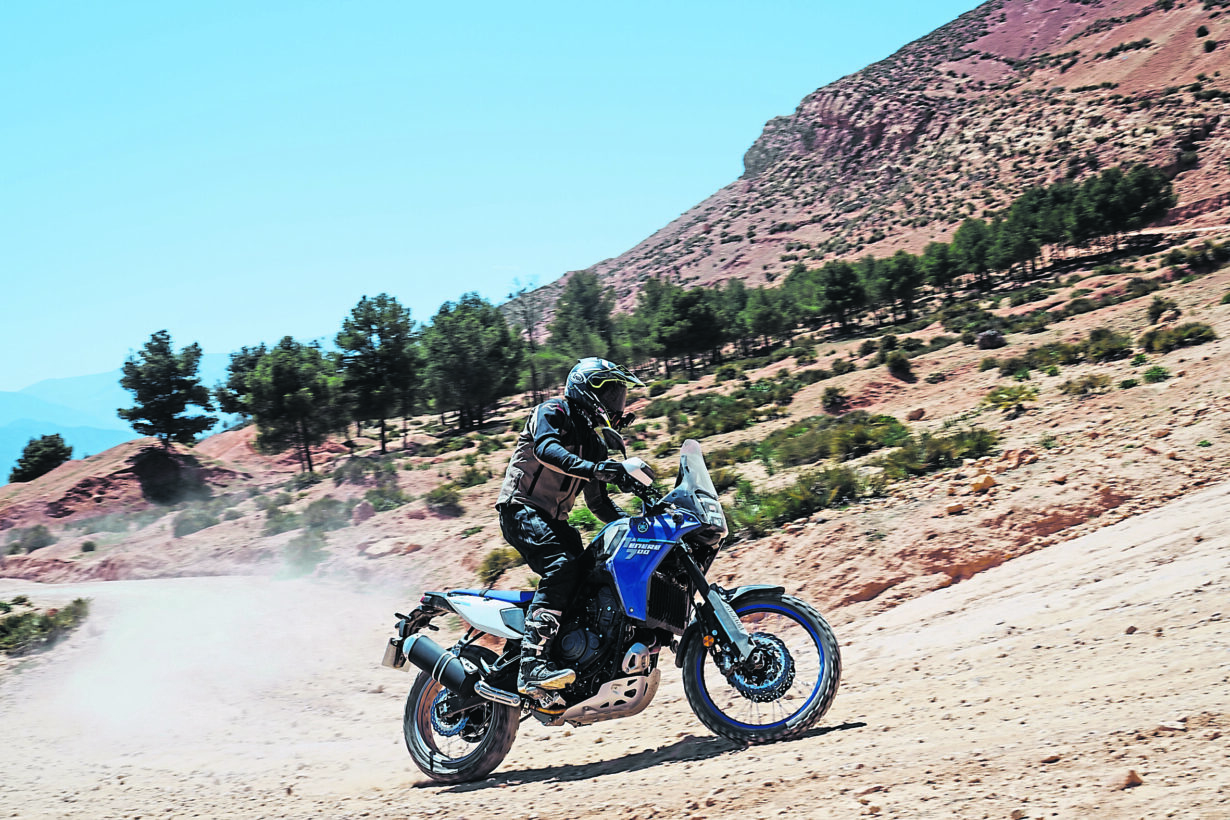
For context, the two bikes largely share the same components, meaning the biggest real difference from a riding point of view was the suspension and the seat height. If the Rally’s was described as bloody tall, the seat height on the Standard is simply tall. But once I was riding and stood on the pegs, the saddle height became irrelevant.
That said, we did undertake a little bit of road riding first on the Standard bike, which gave me the chance to appreciate how firm but spacious it is. With the new design, it’s so much easier to sit that bit farther forward, while cocooned behind the tall, narrow screen. The ergonomics on the bike are hard to fault, being both spacious and relaxed, while the new switchgears have really upped the game, as far as controls are concerned.
As short-lived as our stint on Tarmac was, the Ténéré gave a good impression. But things took a slight change when we got on the dirt. Within a matter of metres it was notable how much less plush and forgiving the suspension was on the Standard bike. It seemed to feel everything that much more and pummeled you in the process, owing to much lesser refined damping characteristics and less travel.
I daresay the experience would have been wholly different had we ridden the base bike before the Rally, but that’s not how the cookie crumbled. What’s also worth noting is that we’d switched from Michelin Anakee Wilds on the Rally, to slightly more road-biased Pirelli Scorpion Rally STRs on the Standard. In essence, this meant we had that bit less grip on the rough stuff, and it showed on a mountain pass we were shooting on soon after leaving the roads. The rear was much more susceptible to coming round on me, albeit sporadically, rather than when asked to. It nearly caught me out a few times, which wasn’t much fun considering the several hundred feet fall that was shouldering the route. I also lacked confidence in the front tyre, which was a lot less telling through the KYB suspension.
It’s at this point that I should say my criticism isn’t to put the Standard bike down, but to reiterate how impressed I’d been with the Rally. It’d simply set a much higher standard than what the base model could match, but with more miles clocked and a better understanding of the model engrained, it did begin to make more sense, and I was still very much enjoying my time on it.
The route back was different to the route to the place we’d switched bikes, with this second half being more trail inclined, taking us on slower, more technical routes, interjected by the occasional mountainside village. The ride was exceptional, made all the better by the smiling and waving locals of the habitats we passed through. It was one of those moments that hammered home the brilliance of motorcycles, riding to places that few people will ever see, undertaking an experience that even fewer will ever know.
That, to me, epitomises the spirit of the Ténéré, that had shone through on both machines. In fact, towards the end of the day’s ride, tired, aching and thirstier than a piece of ancient parchment, it was still depressing to stomach that soon we’d have to hand these bikes back and accept that our joyride was over.
And then a challenge came our way: to race a pro-rider back to camp on a slightly more direct section of desert; the loser bought the beers. Let’s just say, I didn’t want to buy any beers, and one or two of my mates had the same thought. I don’t know if there are speed limits in the desert, but I’m pretty sure we broke all of them on our futile race against an ex-Dakar winner. Obviously, he won, but we won one of the most treasurable of riding experiences ever on that half-hour blast.
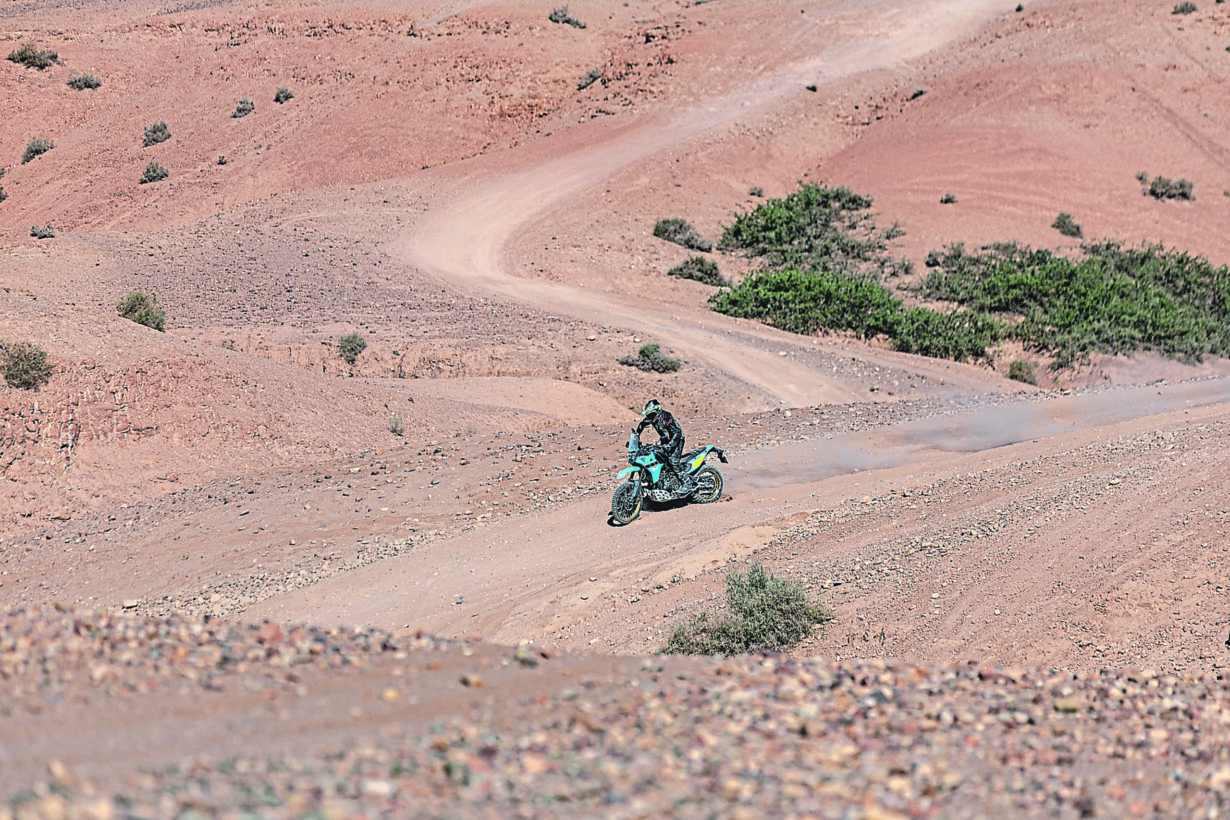
At times the Ténéré had made the most unholy of shapes and I’d accepted a crash was inevitably only a stone’s throw away, but somehow the bike and I made it back in one piece, and a beer was welcomely bought as we retraced our tales from the adventure we’d just shared. My time on the Ténéré had come and gone too soon, but the impression it’d left will take some beating.
In all honesty, while the changes made to the 2025 models are irrefutably significant, the familiarity and pleasure of the Ténéré remain the same as what I’ve experienced on every one I’ve ever ridden. It’s just that the capabilities have been cranked up that bit further, the looks are that bit sharper, and the scope for this bike remaining the best-selling machine in its sector are looking a whole lot rosier.
Specs: Yamaha Ténéré 700 RALLY
Engine:
Type: 689cc, twin-cylinder, liquid-cooled
Bore x Stroke: 80mm x 68.6mm
Compression: 11.5:1
Fuelling: EFI
Claimed Power: 72bhp @ 9000rpm
Claimed Torque: 68Nm @ 6500rpm
Chassis:
Frame: Double cradle, steel tube backbone
F Suspension: Upside down, 43mm forks, fully adjustable
R suspension: Monoshock with full adjustability
Front brakes: Four-piston monobloc calipers, 282mm discs
Rear brake: Single-piston caliper, 245mm disc
Electronics:
Riding Modes: Yes
Traction Control: Yes
ABS: Yes
Quickshifter/Autoblipper: No
Wheelie Control: No
Launch Control: No
Dimensions:
Wheelbase: 1595mm
Seat Height: 910mm
Wet Weight: 210Kg
Fuel Capacity: 16 litres
Info:
Price: £11,404
From: www.yamaha-motor.eu
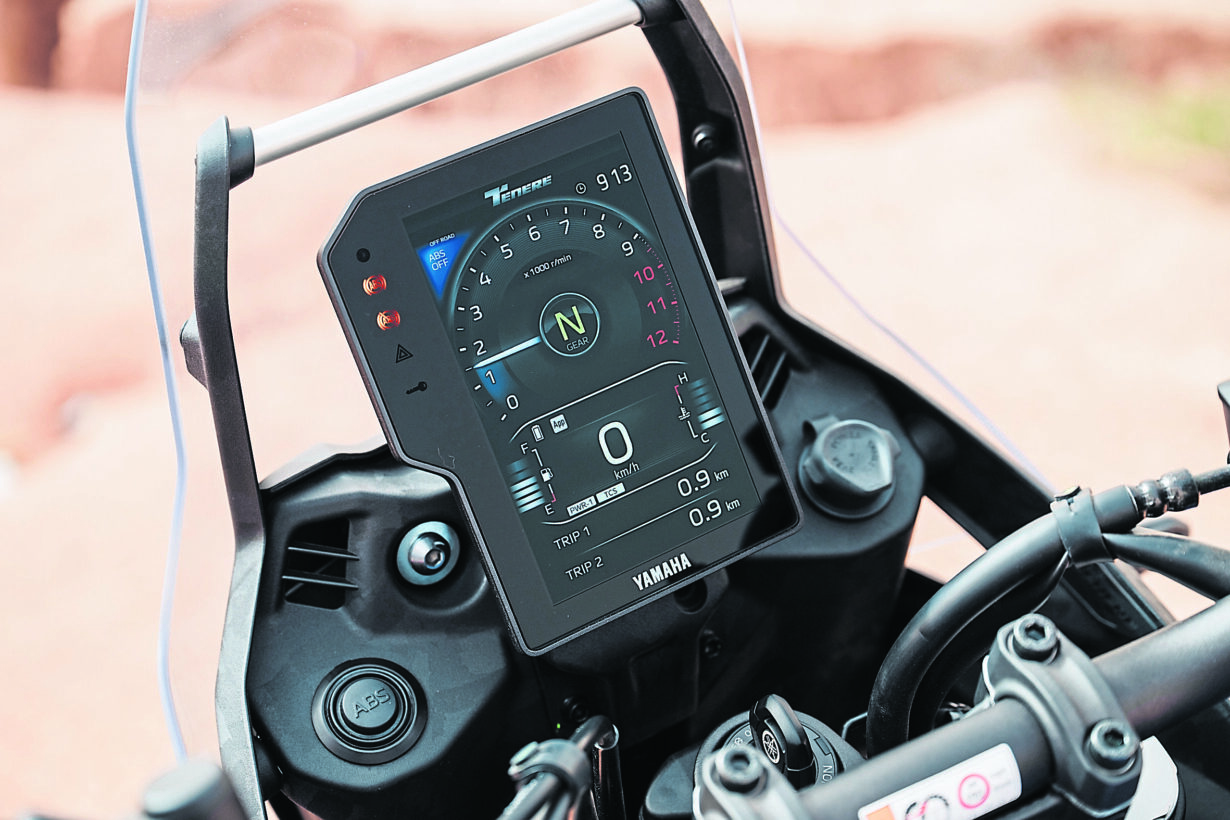
Specs: Yamaha Ténéré 700
Engine:
Type: 689cc, twin-cylinder, liquid-cooled
Bore x Stroke: 80mm x 68.6mm
Compression: 11.5:1
Fuelling: EFI
Claimed Power: 72bhp @ 9000rpm
Claimed Torque: 68Nm @ 6500rpm
Chassis:
Frame: Double cradle, steel tube backbone
F Suspension: Upside down, 43mm forks, fully adjustable
R suspension: Monoshock with full adjustability
Front brakes: Four-piston monobloc calipers, 282mm discs
Rear brake: Single-piston caliper, 245mm disc
Electronics:
Riding Modes: Yes
Traction Control: Yes
ABS: Yes
Quickshifter/Autoblipper: No
Wheelie Control: No
Launch Control: No
Dimensions:
Wheelbase: 1595mm
Seat Height: 875mm
Wet Weight: 208Kg
Fuel Capacity: 16 litres
Info:
Price: £10,404 From: www.yamaha-motor.eu


